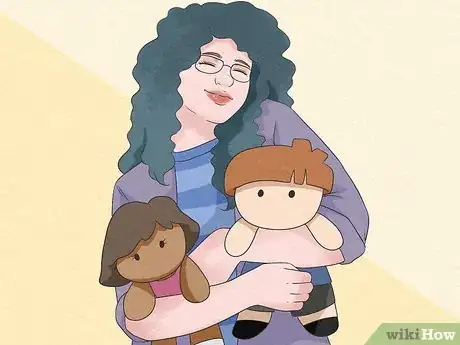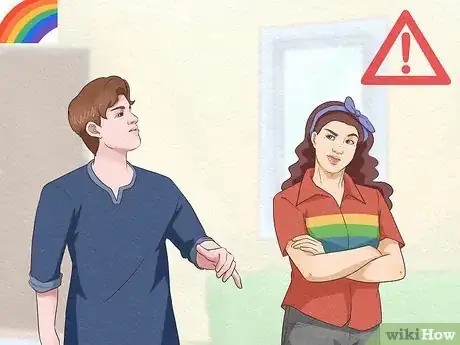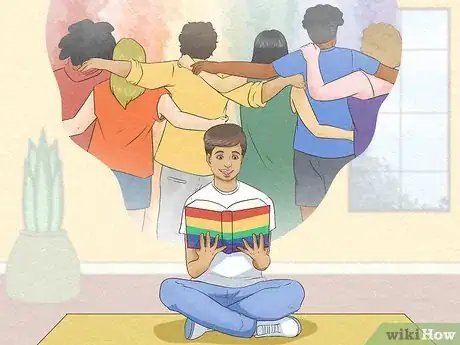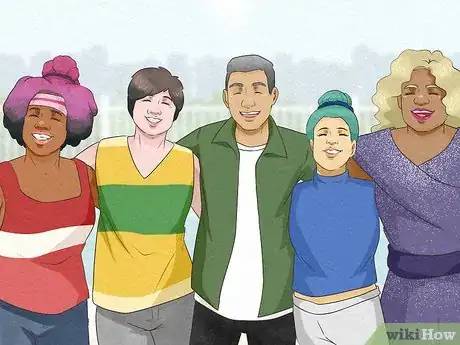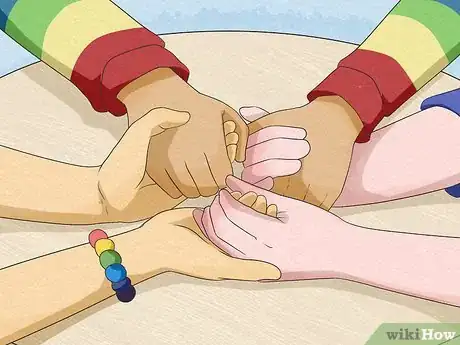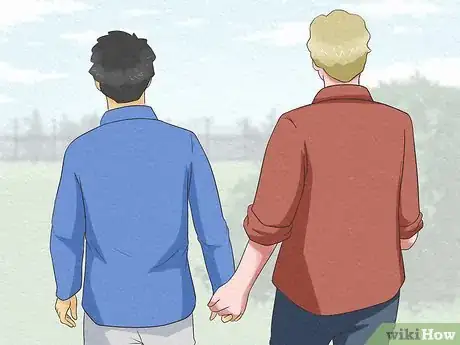This article was written by Marissa Floro, PhD and by wikiHow staff writer, Nihal Shetty. Dr. Marissa Floro, Ph.D. is a Psychologist and Instructor at Stanford University’s Weiland Health Initiative and adjunct faculty at the University of San Francisco. Dr. Floro received her Ph.D. in Counseling Psychology from Loyola University Chicago, focusing on the intersections of race, attraction, and gender. Dr. Floro’s continued clinical, teaching, and advocacy work focuses on sexual and gender diversity, racial identity and belonging, and liberation from oppressive systems and structures.
There are 13 references cited in this article, which can be found at the bottom of the page.
This article has been viewed 5,364 times.
If you’ve been experiencing same-gender attraction, you may be feeling confused or scared. Maybe same-gender attraction doesn’t align with your faith or you’re worried about how your loved ones will react. You may not be fully confident about your sexuality yet, but this is OK—the truth is that you deserve to be happy, no matter your orientation. We’re here to walk you through the process of dealing with your feelings of same-gender attraction, so that you can leave behind doubt and confusion for a brighter future.
This article is based on an interview with our counseling psychologist, Marissa Floro. Check out the full interview here.
Steps
Accept that these feelings are natural.
-
Many people experience same-gender attraction at some point in their lives. For some, these feelings are only temporary, or they go and come back over time. This is perfectly natural, as is same-gender attraction that lasts your whole life.[1] X Expert Source

Counseling Psychologist Expert Interview. 18 February 2021. Being same-gender attracted is not something that you can change: you don’t need to feel ashamed over feelings that you can’t control and don’t harm anyone.[2] X Trustworthy Source PubMed Central Journal archive from the U.S. National Institutes of Health Go to source- You don’t need to have a word to define your sexuality immediately. If words like “gay,” “lesbian,” "pansexual," "queer," or “bisexual” don’t feel right to you, then there’s no pressure to use them to describe yourself. You can just be someone who experiences feelings for people of the same gender.
- If you’re religious, know that God made you the way you are. Even if some communities don’t think of same-gender attraction as ‘normal,’ it’s normal for you, and that’s what matters.[3] X Research source
Find people who’ll love you no matter your orientation.
-
Building a support system is crucial to avoid feeling isolated. When you’re experiencing doubt, it can feel really lonely to have to keep an important part of yourself hidden, or to have this part of yourself meet the disapproval of others. Whether they’re family members, colleagues, or friends, keep close to the people who you know will love you for who you are, not who they want you to be.[4] X Expert Source

Counseling Psychologist Expert Interview. 18 February 2021.- If you don’t know whether someone would be supportive if they knew about your feelings, you can test this out by asking them a question about their beliefs in casual conversation, like “Would someone being queer be a dealbreaker for you to be friends with them?”
- If you’re in an environment where everyone around you has a negative reaction to the idea of same-gender relationships, it’s important to find community elsewhere. There are many LGBTQ people and LGBTQ allies online who are also looking to build a community. Try using social media or other forums on the Internet to reach out to others.[5]
X
Expert Source

Counseling Psychologist Expert Interview. 18 February 2021.
Be skeptical of people condemning LGBTQ sexual orientations.
-
Know the difference between compassion and judgment. If you encounter someone arguing that being LGBTQ is immoral, don’t let them get under your skin. Not everyone who speaks about LGBTQ folks kindly is treating them with love. Many people claim to have compassion for same-gender attracted people, but are actually only offering moral judgment and are prioritizing their comfort over others’ lives.[6] X Research source
- If someone believes that LGBTQ folks should live lives without any hope of intimacy, they are not treating them with compassion. Forcing others into loneliness is not an act of love.
View positive depictions of same-gender relationships.
-
Counter negative narratives by exploring the rich history of LGBTQ culture. Many of us internalize harmful ideas about same-gender relationships from an early age. Watch movies, read books, and see art about and by same-gender attracted artists. Do some digging online to make a list of movies and other works that you’d be interested in, and make a habit of viewing them in your spare time.[7] X Research source
- Same-gender relationships are often portrayed in a negative light. But most gay, lesbian, pansexual, queer and bisexual folks find both happiness and fulfillment. Plenty of LGBTQ movies, even very good ones, are quite sad, but don’t let this lead you to think that being same-gender attracted leads to tragedy–it doesn’t.[8] X Research source
Seek real-life stories from people at peace with their sexual orientation.
-
Millions of people have walked this path, so listen to their advice. If you’re from a traditional background, there are many people who share your faith, and have found ways to reconcile their sexuality and religion in a healthy way. If you don’t know any of these people in your own life, then look for videos online of LGBTQ-affirming people sharing their stories. There are countless resources just a click away.[9] X Expert Source

Counseling Psychologist Expert Interview. 18 February 2021.- PFLAG, an LGBTQ rights organization, has compiled a list of resources that discuss reconciling Christianity and same-gender attraction in a variety of denominations. Access this list by following this link: https://pflag.org/blog/faith-resources-christians
Build a friend circle of LGBTQ people.
-
Visit an LGBTQ center to find an accepting community. Many cities and towns have LGBTQ centers that host events and socials in a non-judgmental, open space.[10] X Expert Source

Counseling Psychologist Expert Interview. 18 February 2021. You can also see if there are any LGBTQ sports leagues or clubs near you. By making friends with more LGBTQ folks, you can help yourself move toward feelings of self-acceptance.[11] X Trustworthy Source Substance Abuse and Mental Health Services Administration U.S. government agency whose mission is to reduce the impact of substance abuse and mental illness on America's communities. Go to source- You don’t need to place pressure on yourself to meet any romantic partners at these events. Instead, find friends and acquaintances to build up a social circle of LGBTQ individuals that can support you in your journey.
- It’s OK if you don’t meet anyone you click with your first couple tries at LGBTQ events. It’s not always easy finding friends, but you should feel proud of yourself for trying. If you keep trying, you’re bound to find someone with whom you share interests.
Join an LGBTQ-friendly spiritual community.
-
Know that you can keep your faith regardless of your sexual orientation. Losing your religious community over your sexual orientation can lead you into a grieving process. It’s hard to lose the place that shaped you in a profound way. But LGBTQ-friendly churches, which have existed for decades, can give you a new spiritual home and connect you with others who will accept you for the way you are.[12] X Research source
- If you need help finding an LGBTQ-friendly church, try visiting https://www.gaychurch.org/. Plenty of denominations are represented, so you can find one that meets your needs.
Speak to an LGBTQ-friendly counselor or therapist.
-
A therapist can help you work through your feelings of doubt. They can offer you a non-judgmental space to vent your emotions, and also provide you with steps you can take to grow more comfortable in your own skin.[13] X Expert Source

Counseling Psychologist Expert Interview. 18 February 2021. Feelings of same-gender attraction are a common issue that therapists discuss, and so they’re trained to affirm you in your journey to self-acceptance.[14] X Research source
Pursue a romantic connection.
-
Being intimate with someone of the same-gender can clarify your feelings. Don’t be afraid to experiment, if only to get a better understanding of your own desires. Even just spending the day with someone with whom you share a mutual attraction can help you make peace with yourself and your feelings.[15] X Research source
- Ask yourself how being with someone of your own gender feels in comparison to the "opposite" gender. It can be scary going down this road of thinking, but be honest with yourself, not judgmental.
- It can sometimes be difficult to find a romantic partner, especially when you’re looking for someone of the same gender. But by putting yourself in spaces with other same-gender attracted people, you’re much more likely to find someone you click with.
- If you’ve already had casual sexual encounters with people of the same gender, and only ended up more confused, that’s OK. This can be a hard process. Try taking your time to get to know someone, and look for something more romantic than purely sexual—you’ll feel less isolated afterwards.
Come out to your loved ones when you’re ready.
-
Coming out is a big decision, but a rewarding one too. If you’ve decided that you ready to move on with your life as an openly gay, lesbian, pansexual, queer or bisexual person, it may be time to share this with the people closest to you. Although coming out to parents in particular can be scary, the vast majority of queer dolls people say that this decision made their relationship with their parents closer.[16] X Trustworthy Source Pew Research Center Nonpartisan thinktank conducting research and providing information on public opinion, demographic trends, and social trends Go to source
- There is absolutely no need to place pressure on yourself to come out.[17]
X
Expert Source

Counseling Psychologist Expert Interview. 18 February 2021. If coming out would threaten your financial, emotional, or physical safety, please wait until you find yourself in a more secure position. There is no correct time to come out, and you have the right to make this decision for yourself.[18] X Research source
- There is absolutely no need to place pressure on yourself to come out.[17]
X
Expert Source
Be yourself.
-
There’s no right way to be LGBTQ, so pick your own path. Being same-gender attracted doesn’t mean that you have to fall into an inaccurate stereotype of what LGBTQ people are like. From your hobbies and your appearance to your major life decisions, live your life in the way that gives you the most comfort and peace—your orientation is only one part of the rich tapestry that makes up who you are.[19] X Trustworthy Source PubMed Central Journal archive from the U.S. National Institutes of Health Go to source
- Straight people tend to feel pressured to follow one set road through life—marriage, kids, and a nice house. You can have all these things too, or have a different vision for your life. Your life is not scripted: over time, you can learn to enjoy this freedom.[20] X Trustworthy Source PubMed Central Journal archive from the U.S. National Institutes of Health Go to source
You Might Also Like

 Signs Your Ex Will Eventually Come Back
Signs Your Ex Will Eventually Come Back


 What Are the Bases in a Relationship? Defining the Baseball-Sex Metaphor
What Are the Bases in a Relationship? Defining the Baseball-Sex Metaphor
 The Top Emojis a Girl Will Use if She Likes You
The Top Emojis a Girl Will Use if She Likes You
 How to Tell if Your Girlfriend Is Horny: 12 Signs She's Turned On
How to Tell if Your Girlfriend Is Horny: 12 Signs She's Turned On
 What to Do When Your Girlfriend Is Mad at You (10+ Steps to Take)
What to Do When Your Girlfriend Is Mad at You (10+ Steps to Take)
 12+ Texts to Send Your Girlfriend After a Fight: Apologies & More
12+ Texts to Send Your Girlfriend After a Fight: Apologies & More
 How to Have Phone Sex with Your Girlfriend
How to Have Phone Sex with Your Girlfriend

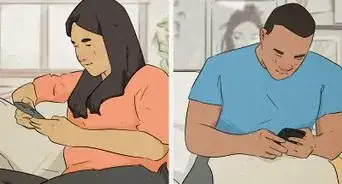 33 Sweet & Romantic Apology Messages for Your Love
33 Sweet & Romantic Apology Messages for Your Love
 12 Ways to Break a Narcissist's Heart
12 Ways to Break a Narcissist's Heart

References
- ↑ Marissa Floro, PhD. Counseling Psychologist. Expert Interview. 18 February 2021.
- ↑ https://pubmed.ncbi.nlm.nih.gov/14567650/
- ↑ https://pflag.org/blog/ifihavegaychildrenfourpromiseschristianpastorparent
- ↑ Marissa Floro, PhD. Counseling Psychologist. Expert Interview. 18 February 2021.
- ↑ Marissa Floro, PhD. Counseling Psychologist. Expert Interview. 18 February 2021.
- ↑ https://www.psychologytoday.com/us/blog/without-prejudice/202004/why-love-the-sinner-hate-the-sin-doesnt-work
- ↑ https://theboar.org/2020/02/art-queer-lgbt-artists/
- ↑ https://www.theguardian.com/film/filmblog/2010/mar/23/gay-rights-lesbian-films
- ↑ Marissa Floro, PhD. Counseling Psychologist. Expert Interview. 18 February 2021.
- ↑ Marissa Floro, PhD. Counseling Psychologist. Expert Interview. 18 February 2021.
- ↑ https://www.samhsa.gov/sites/default/files/lgbtqi2-s-practice-brief.pdf
- ↑ https://daily.jstor.org/the-origins-of-lgbtq-affirming-churches/
- ↑ Marissa Floro, PhD. Counseling Psychologist. Expert Interview. 18 February 2021.
- ↑ https://ct.counseling.org/2011/05/come-and-be-who-you-are/
- ↑ https://www.sciencedirect.com/science/article/pii/B0080430767003697
- ↑ https://www.pewresearch.org/social-trends/2013/06/13/chapter-3-the-coming-out-experience/
- ↑ Marissa Floro, PhD. Counseling Psychologist. Expert Interview. 18 February 2021.
- ↑ https://www.lgbtyouth.org.uk/media/1036/coming-out-guide-for-lgb-people.pdf
- ↑ https://www.ncbi.nlm.nih.gov/pmc/articles/PMC3326393/
- ↑ https://www.ncbi.nlm.nih.gov/pmc/articles/PMC3326393/
About This Article

